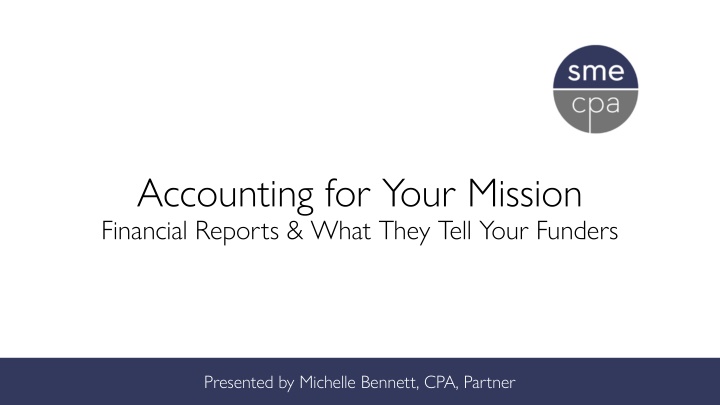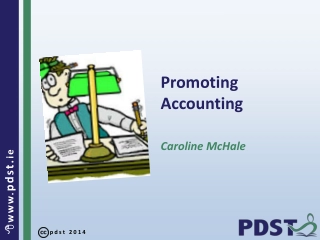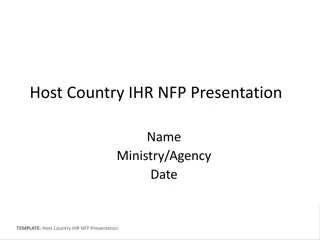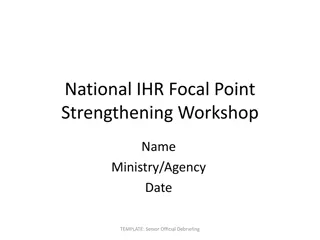
Nonprofit Financial Statements: Importance, Preparation, and Analysis
Learn why nonprofit financial statements are crucial for transparency and accountability to donors and stakeholders. Discover the types of financial statements prepared by CPAs and how understanding these reports can help assess an organization's financial health and make informed decisions.
Download Presentation

Please find below an Image/Link to download the presentation.
The content on the website is provided AS IS for your information and personal use only. It may not be sold, licensed, or shared on other websites without obtaining consent from the author. If you encounter any issues during the download, it is possible that the publisher has removed the file from their server.
You are allowed to download the files provided on this website for personal or commercial use, subject to the condition that they are used lawfully. All files are the property of their respective owners.
The content on the website is provided AS IS for your information and personal use only. It may not be sold, licensed, or shared on other websites without obtaining consent from the author.
E N D
Presentation Transcript
Accounting for Your Mission Financial Reports & What They Tell Your Funders Presented by Michelle Bennett, CPA, Partner
Why are Nonprofit Financial Statements Important? They provide an accurate and comprehensive overview of the organization s financial health. Financial statements for nonprofits also provide transparency and accountability to donors, grantors, and other stakeholders, demonstrating that the organization is responsibly using its funds to achieve its mission. Accurate financial reporting helps to build trust and credibility with supporters, leading to increased funding and other valuable resources for non- profits.
Types of Financials prepared by CPA Compiled Compiled Financial Financial Statements Statements Compilations are typically appropriate when businesses are seeking initial or lower amounts of financing. In these cases, a CPA does not provide any assurance. The CPA does not have to be independent, but the CPA must indicate a lack of independence, if applicable, in the report. The business obtains comfort that the financial statements appear to be appropriate in form and there are no obvious material modifications needed. Reviewed Reviewed Financial Financial Statements Statements Reviews are usually appropriate as a business grows and seeks larger levels of financing. Here, the CPA must be independent from the client. Also, the CPA is required to perform inquiry and analytical procedures as a basis for obtaining limited assurance that the financial statements are free of material misstatement. The CPA issues a report as to whether the CPA is aware of any material modifications that should be made to the financial statements for them to be in accordance with the financial reporting framework. Audited Audited Financial Financial Statements Statements Audits are typically appropriate and often required for complex financing, grant funding or based on the size of the NFP Organization. In these scenarios the CPA must be independent. The CPA is required to perform inquiry and analytical procedures, as well as to obtain an understanding of the business s internal controls and assess the risk of material misstatement, including fraud risk. The CPA is also required to perform verification and substantiation procedures. With an audit the CPA obtains high, but not absolute assurance and issues a report that includes the CPA s opinion as to whether the financial statements are in accordance with the financial reporting framework.
Understanding Nonprofit Financial Statements
Understanding these financial statements enables nonprofit professionals to assess the organization's financial health, identify trends, make informed decisions, and communicate effectively with stakeholders. It's essential to analyze these statements comprehensively and in conjunction with one another to gain a holistic understanding of the organization's financial position and performance.
Statement of Financial Position, The Balance Sheet This statement provides a snapshot of the organization's financial position at a specific point in time, typically at the end of the fiscal year. It presents assets, liabilities, and net assets (or fund balances), giving stakeholders insight into the organization's resources and obligations. Assets include cash, investments, accounts receivable, and property, while liabilities encompass accounts payable, loans, and other debts. Net assets represent the organization's equity or ownership interest and are categorized into without donor restrictions (previously unrestricted) and with donor restrictions (previously temporarily restricted, and permanently restricted funds) based on donor restrictions.
Statement of Financial Position Elements Assets Liabilities Net Assets
Statement of Activities, The Income Statement The statement of activities, akin to the income statement in for-profit entities, summarizes the organization's revenues and expenses over a specific period, typically the fiscal year. It showcases the sources of revenue, such as donations, grants, program fees, and investment income, as well as the costs incurred in fulfilling the organization's mission. The statement helps stakeholders understand the organization's financial performance, including whether it operated at a surplus (revenues exceeding expenses) or a deficit (expenses surpassing revenues).
Statement of Activities Revenue Expenses Gains and losses Changes in net assets
Statement of Cash Flows This statement tracks the organization's cash inflows and outflows during a given period, categorizing transactions into operating, investing, and financing activities. Operating activities include cash receipts and payments related to the organization's primary operations, such as program services and administrative expenses. Investing activities involve cash transactions related to the acquisition or sale of assets, such as property or investments. Financing activities encompass cash flows from borrowing, repaying loans, or receiving contributions from donors.
Statement of Cash Flows Format Three sections Operating activities Investing activities Financing activities
Statement of Functional Expenses The statement of functional expenses provides a breakdown of the organization's expenses by function and nature, offering transparency into how resources are allocated across various programs and activities. It categorizes expenses into program services, supporting services (such as management and fundraising), and sometimes further divides them by specific programs or activities. This statement aids stakeholders in evaluating the organization's efficiency and effectiveness in utilizing resources to achieve its mission.
Statement of Functional Expenses The costs of various Foundation activities have been accounted for on a functional basis in the statements of activities. The statements of functional expenses present expenses by function and natural classification. Where practicable, expenses are directly classified to specific program or supporting service categories. Costs that are not specifically identifiable within functional categories are classified using allocation methods such as time studies, square footage and other methodologies. Develop an allocation method that makes sense for your Organization Functional expense allocation is one of the most commonly referred to items when it comes to the public nature of a NFPs financial statements.
Statement of Functional Expenses Best Practices For For natural natural categories, categories, less less is is more more.. Evaluate what level of detail is appropriate for the users of your financial statements. There isn t a one-size-fits-all answer, but for the majority of NFPs, somewhere between five and ten categories should meet the needs of most users. Programs Programs should should tell tell your your story story.. The NFP financial reporting standards suggest disaggregation of the major classes of program services on NFP financial statements as a way of meeting the requirement to report expenses by functional classification. Take Take credit credit for for what what your your employees employees do do.. The NFP financial reporting standards have clarified an area of previous ambiguity in that certain expenditures, such as those related to accounting and human resources, should be reported as management and general expenditures because they benefit the organization as whole. NFPs can still make an argument to allocate at least a portion of these expenses to program services if these employees spend time on programmatic matters. Before settling on an allocation methodology for certain salary expenses, hold discussions with your staff so that you can take credit for program service activities your employees actively participate in. Review Review your your allocation allocation methodologies methodologies.. Another requirement of the NFP reporting standards is to disclose the specific methodologies you use to allocate expenses to program and supporting services in your financial statements. NFP financial statement preparers should review their methodologies and ensure they are reasonable.
How often to keep your books updated? Many factors play a part Depends on the number of financial transactions as well as the complexity of those transactions Estimated guidelines: 50 100 transactions per year (low number of transactions) ~ Annually 100 200 transactions per 6 months or quarter ~ Semi- annually/quarterly 200 plus transactions a month ~ Monthly (high volume of transactions)
Gifts-in-kind: Reporting contributions of nonfinancial assets Determining the fair value of cash and marketable securities is typically straightforward, but for most nonfinancial assets (for example, food, supplies, used clothing and household items, intangibles, medical equipment, and pharmaceuticals), the valuation process is less clear. Accurate valuation and revenue recognition of nonfinancial gifts (commonly referred to as gifts-in-kind, or GIK) are a challenge, particularly for GIK that are used by the NFP for program activities and not subsequently sold in the marketplace. (Sales data provides valuation evidence for items sold, so those generally are not problematic transactions.) The basic guiding principles for determining the fair value of GIK have not changed over the years. However, NFPs understanding of the characteristics and issues surrounding GIK has matured, best practices have developed for addressing issues, and the markets transacting in GIK are evolving. Reporting the revenues and expenses resulting from GIK demonstrates how much an NFP depends on noncash contributions to perform its mission. When used properly, GIK can greatly extend the cash resources of NFPs because the GIK often consist of goods and services the organizations would otherwise have to purchase. Valuation in these cases would be based on cost if the NFP purchased outright. Identifying publicly available inputs to fair value measurement can be challenging. Some GIK are items that the NFP would not otherwise buy and, therefore, the NFP may be unfamiliar with the markets for those items. Some GIK items do not trade in active markets that publish pricing information. An NFP may sell GIK items (and, therefore, have exit prices), but if the NFP s sales do not reflect the item s highest and best use, the sales prices are not fair value. Despite the challenges of valuation, NFPs should make a good faith estimate of fair value by searching for transaction data for actual transactions in active markets they can access.
What Does a Fair Value Measurement Mean When It Comes to GIK Contributions? Fair value is defined as the price that would be received to sell an asset or paid to transfer a liability in an orderly transaction between market participants at the measurement date (FASB ASC Glossary). However, an NFP receives these assets as a contribution, not as a market participant. Thus, the NFP has a hypothetical consideration: Which market would it use if it were to sell the goods? Would the goods be sold in an exit market as a retailer, wholesaler, or manufacturer, or would they be sold in some other market? What if the NFP does not have access to sell the goods in any market? Certain GIK may not have a readily determinable marketplace, but typically, they have a base utility that is marketable to someone. NFPs should consider that base utility when determining market values for GIK.
Disclosures related to contributed nonfinancial assets For each category of contributed nonfinancial assets, an NFP also must disclose the following: Qualitative information about whether contributed nonfinancial assets were either monetized or utilized during the reporting period. If utilized, a description of the programs or other activities in which those assets were used shall be disclosed. The NFP s policy (if any) about monetizing rather than utilizing contributed nonfinancial assets. A description of any donor-imposed restrictions associated with the contributed nonfinancial assets. A description of the valuation techniques and inputs used to arrive at a fair value measure in accordance with FASB ASC 820-10-50- 2(bbb)(1), at initial recognition. The principal market (or most advantageous market) used to arrive at a fair value measure if it is a market in which the recipient NFP is prohibited by a donor-imposed restriction from selling or using the contributed nonfinancial assets. An entity (NFPs and business entities) that receives contributed services must describe the programs or activities for which those services were used, including the nature and extent of contributed services received for the period and the amount recognized as revenues for the period. Entities are encouraged to disclose the fair value of contributed services received but not recognized as revenues if that is practicable. The nature and extent of contributed services received can be described by nonmonetary information, such as the number and trends of donated hours received or service outputs provided by volunteer efforts, or other monetary information, such as the dollar amount of contributions raised by volunteers. Disclosure of contributed services is required regardless of whether the services received are recognized as revenue in the financial statements.
Analyzing the financial statements Period to period comparisons Can be done across various periods such as monthly, quarterly or annually Allows you to see peaks or valleys in financial information May provide insight on how certain market conditions effect your bottom line Budget to actual comparisons Assists in controlling and monitoring spending Helps determine revenue fluctuations Regular review can assist with staying on task with spending and reach goals
Analyzing the financial statements The selection of a set of ratios to monitor is challenging because not-for-profit missions vary extensively, as do their sizes and the industries in which they operate. The most accurate statement that may be made about the choice of ratios to monitor is that no single set of ratios is suitable for all not-for-profits. The management team of each not-for-profit should consider its needs and select a set of ratios to measure that address its particular concerns. Regardless of the specific ratios selected, two characteristics make ratio analysis more useful: Trend Trend analysis analysis. Within an organization, the value of ratio analysis lies in directing management s attention to areas of changing conditions. Therefore, it is important to measure and report financial ratios across time. Once agreed upon, the selected ratios should be consistently measured and presented to the governing board within each financial report so that trends can be identified. Benchmarking Benchmarking.. No generally accepted ideal or target levels exist for ratios. The desirable level for a given ratio is a matter of judgment and will vary according to the circumstances facing each organization. Ratios are generally evaluated against a benchmark rather than a theoretically optimal value; these benchmarks are typically calculated as an average value from a comparison group. Therefore, in addition to agreeing upon a set of ratios to measure and monitor, each not-for-profit should also agree on a comparison group of five to ten peer organizations. Ideally, this group would consist of well-managed not-for-profits of similar size and mission.
Using Financial Statements to Communicate with Funders
Financial statements serve as a crucial tool for nonprofits to effectively communicate with their funders, including donors, grantors, and other stakeholders. Here's how nonprofits can leverage financial statements to build trust, transparency, and credibility with funders.
Strategies for Effective Communication Clarity Clarity and understandable to non-financial stakeholders. Avoid jargon and provide explanations for any technical terms or concepts. Visual Visual Representation Representation:: Incorporate visual aids such as charts, graphs, and tables to enhance the clarity and visual appeal of financial data. Visual representations can help funders grasp complex financial information more easily. Storytelling Storytelling:: Supplement financial data with compelling narratives and stories that illustrate the impact of the organization's work. Share real-life examples of how funding has been utilized to achieve meaningful outcomes and advance the organization's mission. Tailored Tailored Reporting Reporting:: Customize financial reports to meet the specific needs and preferences of different types of funders. For example, individual donors may appreciate personalized reports highlighting the direct impact of their contributions, while institutional funders may require more detailed financial analysis and compliance with reporting requirements. and Transparency Transparency:: Present financial information in a clear and transparent manner, using language that is easily
Building Trust and Credibility Clarity Clarity and understandable to non-financial stakeholders. Avoid jargon and provide explanations for any technical terms or concepts. Visual Visual Representation Representation:: Incorporate visual aids such as charts, graphs, and tables to enhance the clarity and visual appeal of financial data. Visual representations can help funders grasp complex financial information more easily. Storytelling Storytelling:: Supplement financial data with compelling narratives and stories that illustrate the impact of the organization's work. Share real-life examples of how funding has been utilized to achieve meaningful outcomes and advance the organization's mission. Tailored Tailored Reporting Reporting:: Customize financial reports to meet the specific needs and preferences of different types of funders. For example, individual donors may appreciate personalized reports highlighting the direct impact of their contributions, while institutional funders may require more detailed financial analysis and compliance with reporting requirements. and Transparency Transparency:: Present financial information in a clear and transparent manner, using language that is easily
Demonstrating Impact Outcome Measurement: Outcome Measurement: Link financial data to programmatic outcomes and impact metrics to demonstrate the effectiveness of the organization's initiatives. Show funders how their contributions directly contribute to achieving measurable results and making a difference in the community. Evaluation and Reporting: Evaluation and Reporting: Implement robust evaluation mechanisms to track and measure the outcomes and impact of funded programs. Share evaluation findings and progress reports with funders regularly, highlighting successes, lessons learned, and areas for improvement. Long Long- -Term Sustainability: Term Sustainability: Emphasize the organization's financial sustainability and long-term viability in financial communications with funders. Articulate strategies for diversifying revenue sources, managing risks, and ensuring the organization's continued ability to fulfill its mission over time.
Case Study #1 Background: The Community Development Organization (CDO) is a nonprofit dedicated to revitalizing underserved neighborhoods through affordable housing, economic development, and community engagement initiatives. As a grassroots organization, CDO relies heavily on grants and donations to support its programs and services. Challenge: CDO is seeking funding to expand its affordable housing program, but it faces stiff competition for limited grant dollars. To secure funding, CDO must effectively communicate its financial health, demonstrate the impact of its programs, and illustrate its capacity for responsible stewardship of resources.
Case Study #1 Solution: CDO prepares a comprehensive financial report highlighting its financial statements, including the statement of financial position, statement of activities, and statement of cash flows. The organization supplements the financial data with narratives and visuals showcasing the impact of its affordable housing program, such as testimonials from residents, before-and-after photos of renovated properties, and statistics on housing affordability in the community. CDO also includes an analysis of key financial ratios, such as the debt-to-equity ratio and program efficiency ratio, to demonstrate its financial stability and operational efficiency. Additionally, CDO provides a detailed budget for the proposed expansion of its affordable housing program, outlining how grant funds will be utilized and the expected outcomes. Outcome: The transparent and compelling financial presentation resonates with funders, who are impressed by CDO's financial management practices and the tangible results of its programs. As a result, CDO successfully secures the funding needed to expand its affordable housing program, enabling the organization to continue making a positive impact in the community.
Case Study #2 Background: The Environmental Conservation Nonprofit (ECN) is dedicated to protecting and preserving natural habitats and biodiversity through conservation initiatives, advocacy campaigns, and educational outreach programs. ECN relies on a combination of grants, corporate sponsorships, and individual donations to support its work. Challenge: ECN is facing increased pressure to demonstrate the effectiveness of its conservation efforts and attract new funding partnerships. To do so, the organization must effectively communicate its financial sustainability, programmatic impact, and commitment to environmental stewardship.
Case Study #2 Solution: ECN prepares an annual report that integrates financial statements with narratives and visuals illustrating the organization's conservation achievements. The report highlights key financial metrics, such as fundraising efficiency and overhead ratio, to showcase ECN's financial efficiency and transparency. In addition to financial data, the report features success stories from conservation projects, photos of protected ecosystems, and testimonials from community members and partner organizations. ECN also includes a section on sustainability initiatives, detailing its efforts to minimize environmental impact through responsible resource management and green practices. Outcome: The annual report serves as a powerful communication tool, capturing the attention of funders, donors, and other stakeholders. ECN's transparent and impactful presentation of financial and programmatic information inspires confidence and trust among funders, leading to increased support for its conservation efforts. The organization is able to secure new funding partnerships and expand its reach, furthering its mission of environmental conservation and stewardship.
Top accounting tips Avoid mixing personal with business Regularly reconcile bank and credit card accounts Understand how to correctly record transactions Know and understand your payroll tax liability obligations and deadlines Regularly review and understand your financial position Develop an allocation plan for expenses and regularly review and update the Plan as the Organization grows Consult with a professional
Takeaways Keep accounting records up to date. Know how transactions effect each statement. Understand what your statement of financial position and statement of activities are reflecting for your Organization. Review statement of financial position and statement of activities regularly and provide up to date data for your Board. Determine key performance indicators for your industry or business
Questions? Contact information: Michelle Bennett mbennett@smecpa.com 706-722-5337






















